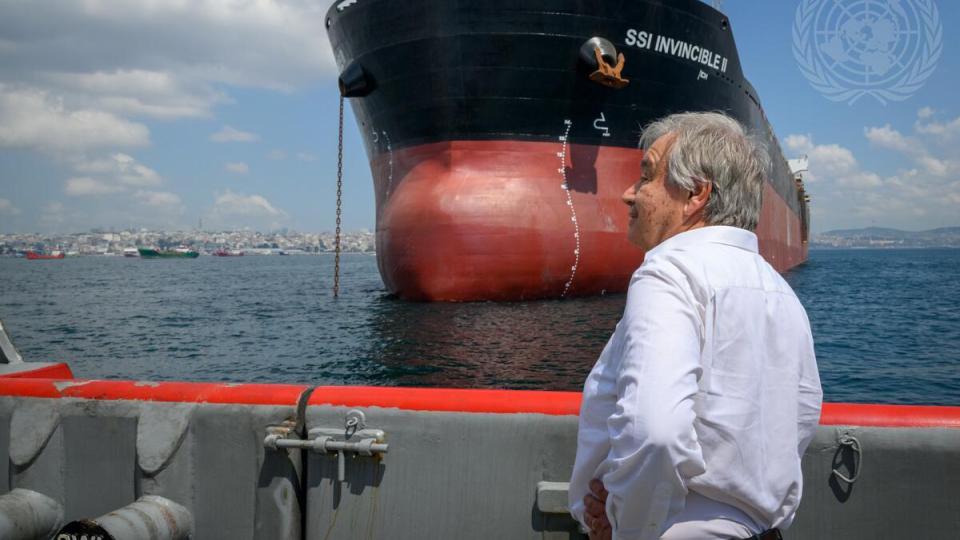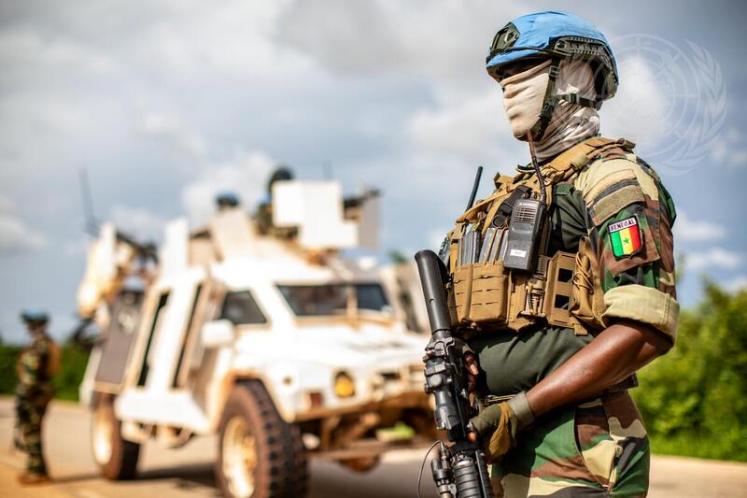The much-awaited New Agenda for Peace (NA4P) policy brief has just been published by United Nations Secretary-General António Guterres. Coming 30 years after Boutros Ghali’s An Agenda for Peace, the NA4P is in many respects the opposite of the original. In 1992, the UN was experiencing a high watermark of international cooperation, with a post-Cold War optimism fueling hundreds of Security Council resolutions, 15 new peace operations, and a steadily increasing investment in multilateralism. This allowed the Agenda for Peace to state in clear terms what the UN’s peace and security architecture could deliver: prevention, peacemaking, peacekeeping, and peacebuilding. Yes, the world was a complex place in 1992, but the ability of the Secretary-General to offer a clear value proposition for the UN was relatively easy, assured of a soft landing within a UN system experiencing a surge in confidence.
In contrast, today’s NA4P comes at a time of nearly unprecedented geopolitical fracture, deep divisions amongst major powers, worrying trends towards militarization, and a set of emerging risks for which the UN system seems poorly prepared. The result is a more defensive proposition by the NA4P, one that must assert a role for the UN in a landscape where international cooperation is increasingly marginalized and contested. If the audience of this brief is Member States – and it certainly feels that Member States are the target – then they are likely to take a lot of convincing to adopt many of the recommendations around improving cooperation.
In contrast, today’s NA4P comes at a time of nearly unprecedented geopolitical fracture, deep divisions amongst major powers, worrying trends towards militarization, and a set of emerging risks for which the UN system seems poorly prepared.
Critics of the NA4P will surely point to the enormous gulf between the pessimistic assessment of geopolitics today and the Secretary-General’s call for the UN to be at the core of global conflict prevention. Indeed, in some respects, the document mimics the overwhelming confluence of today’s risks, offering a long list of recommended actions that may feel disconnected from reality.
Cynics may dismiss these aspects of the policy brief as a scattered attempt to protect the UN at a time when it is under duress and struggling to show results, rather than the bold declaration of the original Agenda for Peace. While these criticisms have some merit, this brief argues that the NA4P also has the potential to drive important shifts in the multilateral system toward: (1) a political economy approach to conflict, (2) a universal paradigm of prevention, (3) more meaningful support to regional actors, and (4) a convergence of norms around emerging risks. Though far from perfect, the NA4P also offers a potentially transformative model for the Declaration for Future Generations in 2024, one where a set of broad norms around emerging risks could be crystallized and made central to the UN’s work going forward.
Promoting a Political Economy Approach to Conflict
One of the most striking aspects of the NA4P is its strong connection to the political economy of conflict. In some areas, the link is clear, such as the detailed call for better financing for peace, aligning the investments of international financial institutions with underlying causes of conflict, and the creation of new funding windows to address climate-driven conflict risks.
But perhaps the most far-reaching set of recommendations concerns military spending and a call for “reducing the human costs of weapons.” As laid out in a recent report by the Institute for Economics and Peace, one of the central factors driving conflict today is the current trend towards militarization, which includes spending on both strategic and small arms. The NA4P’s call for a specific commitment to de-militarization, accompanied by national plans to regulate and reduce weapons, is a clear push to align financing away from military spending and towards a financing for peace paradigm. And its recognition of the links between inequality and conflict suggests that the future of conflict prevention might be much more economically driven.
This political economy approach to conflict prevention is reflected in one of the most remarkable recommendations in the NA4P policy brief, which calls on Member States to use the Secretary-General to “protect global supply and energy chains and prevent economic links from fraying.” This is a reference to the Secretary-General’s Black Sea grain initiative, which unlocked Russian exports of food and fertilizer despite the Ukraine-related sanctions against Moscow. While certainly a success (until this week), the Black Sea initiative also reflects the very limited space for the UN to lead peacemaking in today’s conflicts. Rather than convening parties around a proposed peace plan, the focus on protecting supply chains and disruptions in international markets suggests that the UN may need to switch gears (downward?), mitigating the negative economic and human security impacts of conflict, while working on more medium-term reductions in military spending.
Critics of this approach will likely wax nostalgic about a (largely imaginary) heyday of UN peacemaking, where Secretaries-General appeared able to lock leaders in rooms to hash out peace plans. Indeed, there is a sizeable gulf between a deal that allows fertilizer out of Russia and a comprehensive peace plan for Ukraine. But perhaps the NA4P is right to focus more on the economic side of things. Maybe the political space for diplomacy is so narrow today that the best/only role for the UN is to drive less contentious approaches to alleviate suffering and begin to address the economic drivers of conflict. Certainly the Secretary-General’s focus on reform of the international financial institutions, when read alongside other initiatives to use financial flows to address underlying inequalities, suggests that economics is the main game today

The End of UN Peacekeeping?
The NA4P policy brief was published only weeks after the Security Council took the extraordinary decision to end MINUSMA’s deployment in Mali, following a request by the military coup leaders for the operation to leave. Experts have suggested that this may herald the end of the era of big multidimensional peacekeeping as we know it. Unfortunately, the NA4P does not offer much of a vision of what the next era might be.
The NA4P call for the primacy of politics, realistic mandates, better integration, better use of data, early planning for mission exit, and more nimble approaches are all well-worn mantras from the famous report of the High-Level Panel on Peace Operations and the Action for Peacekeeping Initiative. There is nothing new here, though the ideas remain good ones. And the suggestion that the Security Council and General Assembly should “undertake a reflection on the limits and future of peacekeeping” just begs the question of what the future of peacekeeping should be. Surely, that reflection should have been at least part of the function of the NA4P, rather than what feels like an AOB item. And when paired with the call to give the AU access to the UN’s assessed budget, the implicit message seems to be one of resignation and retreat on UN-led peacekeeping.
Perhaps this is a good thing. A future where the UN’s contribution is mainly through smaller political missions, without much of a military footprint, could better align expectations with reality. If the original Agenda for Peace captured a geopolitical momentum towards greater international investment in robust peacekeeping, the NA4P might be capturing the pendulum moving in the opposite direction. There could be many upsides to a new era of peace operations focused on political engagement and support to actors closer to the ground, with regional organizations in a position of strategic leadership. And if implemented, the NA4P recommendations for strengthening and expanding the PBC might help to fill gaps, even when peacekeeping may be in retreat.
There could be many upsides to a new era of peace operations focused on political engagement and support to actors closer to the ground, with regional organizations in a position of strategic leadership.
There is a risk, though, that the NA4P’s lack of vision on peacekeeping means the UN drifts into that reality without strategically planning for and shaping it. What happens to the UN’s ability to monitor and respond to human rights violations when there are no military protections or team sites for human rights workers in the field? What other security actors may be emboldened by the withdrawal of peacekeepers from areas like eastern Congo or Mali? What signals are given to authoritarian leaders when the stick of peace enforcement becomes more of a wagging finger? The NA4P’s proposed “reflection on the future and limits of peacekeeping” should be driven by a clear-eyed acknowledgement of what we stand to lose in a post-multidimensional-peacekeeping era, and a sense of what should come next.
Guardrails for Emerging Risks
Unsurprisingly, some of the most innovative thinking in the NA4P concerns emerging risks, notably those related to climate change, biological threats, outer space, and artificial intelligence (AI). Across these domains, we see an effort by the NA4P to put guardrails in place by formalizing norms and driving convergence around risk mitigation.
For example, when faced with the very real risk of escalation in cyberspace, the NA4P calls for a normative declaration that basic infrastructure essential for civilian life should be “off limits” to attack. Paired with the proposal for an independent accountability mechanism on cyberspace, this recommendation would see a normative advancement accompanied by some teeth, potentially filling an important gap in our global governance architecture. Similarly, the Secretary-General’s longstanding call to prohibit certain types of lethal autonomous weapons systems is transformed in the NA4P into a proposal for a legally binding instrument, again trying to add some teeth to a growing norm. The NA4P’s push for clearer norms and rules around the safe use of outer space would also address the very real risk of great power confrontation outside our atmosphere. And the proposals around AI, biological threats, and other emerging risks, follow a similar pattern of ‘norm + rule + (some) teeth.’
Taken together, these recommendations reflect the difficult position of the UN as a Member State-driven, bureaucratic organization that is often slow to respond to emerging risks. Realistically, the UN will not be the place where technological innovation happens, but the NA4P recognizes that it might be where some of the norms around highly contested arenas are brought together and attached to some accountability.
Towards the Summit of the Future
The NA4P policy brief has no formal status within the General Assembly and no guarantees of landing at the Summit of the Future. It is also a work in progress, reflecting the Secretary-General’s evolving thinking at a time of great uncertainty about the UN’s role in today’s fractured geopolitical landscape. This presents both risk and opportunity. The risk is that Member States will do what they usually do when confronted with new ideas: reject those that place responsibility on them to make uncomfortable compromises and focus instead on tinkering with the UN Secretariat.
It is likely that most of the conversations over the coming months will focus on how to increase the capacities of the PBC, or other incremental improvements within the UN. The big questions like reforming the Security Council, meaningfully shifting our approach to peacekeeping, or addressing the complex risks posed by emerging technologies are likely to be parked for now as “too sensitive” or “lacking political will.” As with the 90 proposals in the Our Common Agenda report and the 65 recommendations in the report of the High-Level Advisory Board on Effective Multilateralism, Member States will tend to let the bolder issues fall into the background through neglect.
But the uncertainty over the shape of the Summit of the Future represents an opportunity as well. I have listened to dozens of conversations by Member States and major stakeholders in the Summit process: none of them has a fixed sense of what the Summit should be, and many are worried about how to keep up with the dozens of tracks running simultaneously. Although the NA4P is far from perfect, and in many respects has fallen into the trap of reflecting, rather than shaping, the contested geopolitics of today, it also offers a possible model for the main deliverable of the Summit: The Declaration for Future Generations.
Although the NA4P is far from perfect, and in many respects has fallen into the trap of reflecting, rather than shaping, the contested geopolitics of today, it also offers a possible model for the main deliverable of the Summit: The Declaration for Future Generations.
When confronted with a range of uncertain risks, the NA4P proposes a formula of: (1) convergence around basic norms, (2) tying those norms to structures that can independently develop and verify them, and (3) adding on some form of accountability/teeth. It also suggests that orienting the world’s financial flows to address risks and deliver for people is the top priority, and advances the principle that prevention is a universal prerogative, not something the West does in other parts of the world.
Those leading the negotiations on the Declaration for the Future should take note of this approach. What if the Declaration was thought of as a norm-crystallizing moment, one where Member States gathered around a relatively small number of transformative propositions, including: (1) future generations have rights and those rights need to be protected today; (2) humans, not machines, should make decisions that affect all of humanity; (3) human and planetary wellbeing are compatible goals that must be pursued together; and (4) our spending should reflect our collective, universal interest in peace. From a small set of norms like this, one could imagine a cascade effect where our measures of progress would need to account for future impacts, where a ban on AI-controlled strategic weapons systems would be agreed, and where our financial system was aligned behind a just, green transition away from military spending. As Anne-Marie Slaughter and Tom Hale argue, the Declaration should serve as a catalyst for broader systemic change.
If this approach sounds familiar, it should. This is how the Universal Declaration of Human Rights worked 75 years ago. It stood for a straightforward set of principles we all believe in, things like “torture is wrong” and “everyone has a right to nationality.” From this, a complex web of international institutions, processes, and accountability mechanisms emerged, becoming what is today an extraordinary global governance system for human rights. When Member States begin the inevitable triage between now and the Summit of the Future, one of the most important things to preserve may be this concept of converging norms to address the uncertainties of tomorrow. And, somewhat surprisingly, we might have the New Agenda for Peace to thank for pushing us in that direction.



